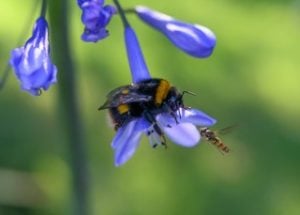Put nature first for the new year and the new decade
The
start of a new year is always a time for resolutions and commitments for the
coming twelve months, and with this year seeing the beginning of a new decade,
any new commitment can have even more significance. So with that in mind, why
not commit to making your garden more wildlife-friendly for the coming year and
decade?
The
justification for looking after wildlife has never been stronger as the
pressure, brought about by the climate emergency, has never been more
significant. Add to this the loss of habitat due to changes in farming practice
and the never-ending need for more space for housing, and you can see why we
all need to do as much as we can to look after the wildlife in our own back
yard - quite literally.
Some
may think that making changes to the way you tend your garden will make little
or no difference to the wider natural world, but the Wildlife Trusts estimates
that our gardens cover an area of around 10 million acres spread between 24
million gardens. That’s a larger area than is covered by nature reserves! This
is a vast area, so if we can make changes on that sort of scale, we can make a
significant difference to the plight of our native plants and animals.
Changes
need only be simple, like creating a log pile, planting insect-friendly plants
and including water to the garden. But what could be the biggest challenge is
not making physical changes, its changing attitudes. Many of us have been
brought up to look upon unkept lawns and weeds in flowerbeds as wrong and
something to change, when in fact the truth is quite the opposite. Longer grass
provides habitat, and ‘weeds’ provide food to insects which in turn feed birds.
But
it’s not just birds that will benefit from these wild areas. Bees are under
threat from pesticides and the loss of wildflowers. These vital pollinators
often go unnoticed, but without them, we would starve, so it is essential that
we do whatever we can. Bats too will be more than happy to see more flying
insects in your garden, and during summer months swallows, swifts and house
martins will also appreciate the additional food source. With a number of
neighbouring gardens going a little wild, your local area will soon become a
haven for more wildlife. We need to encourage the insect population as the
decline has been happening for many years. Not that long ago the summer would
mean we all needed to clean our windscreens regularly to remove dead flies.
When we the last time you needed to do it?
If
you want to provide even more opportunities then bug hotels, hives for solitary
bees and ladybird homes are all low-cost additions that can help diversify the
range of insects that call your garden home. As mentioned before, the addition
of water plays a major factor in encouraging wildlife into a garden. These need
not be significant excavations creating an ornate pond, just a modest-sized container
partly submerged can be all that’s needed. And if that’s not for you, then a
birdbath will be very welcomed providing, as they do, both drinking water and
water in which to bathe. Food is the most obvious enticement for both birds and
a wide range of animals such as hedgehogs and badgers. The wider the variety of
food on offer, the better.
As we start the new year and a new decade, during which we must tackle the climate emergency, or it will be too late, it’s vital that we make some real changes. Changes to our gardens will require both a small amount of physical effort but maybe an even more significant change to our habits. It may not be easy, to begin with, but the results couldn’t be more critical.
© Phil Pickin 2020



